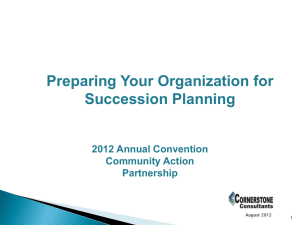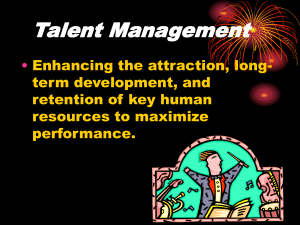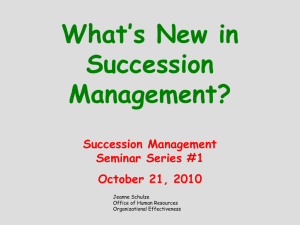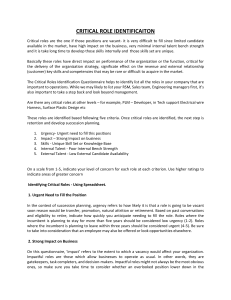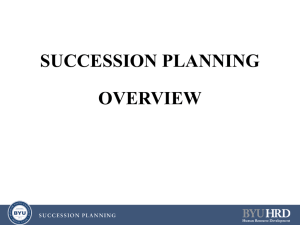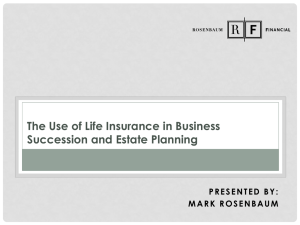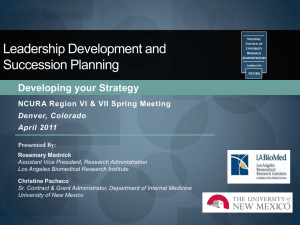1_0950-1035_GlaxoSmithKline
advertisement
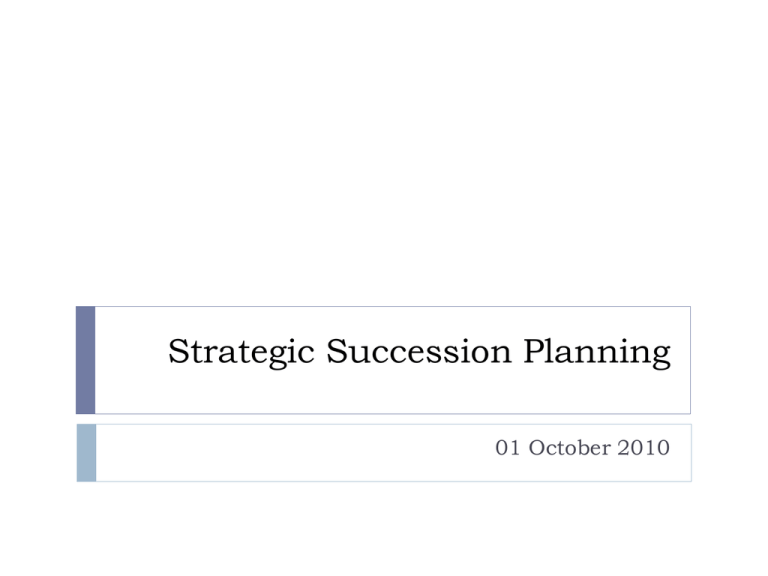
Strategic Succession Planning 01 October 2010 Demand Supply Future Key Roles and Capabilities Identification Top Down process driven by business strategy Bottom up process feeding succession pools to key roles What We Need • Performance • Potential GAP Analysis Plan to Close Gaps Develop/Recruit What We Have • Performance • Potential Talent Review/Succession Planning Strategic Business Planning Process Succession Planning Process at a Glance Top Pressures Driving Succession Planning Changing business landscapes requiring new skills Shortage of available talent in market Losing key leaders to competitors Organisations know that leadership is something they cannot do without and when it gets scarce they need to get better at finding and developing it Barriers to successful strategy implementation Requirements for success: Process Valid and reliable process in place to identify high potentials early in their careers Performance review ratings Multi-rater/360 degree assessment Customer or client feedback Hiring manager or supervisor feedback Formal and consistent process shared across organisation Performance and Potential High Potential High Performers Learns quickly in first-time situations Produce results with the right behaviors Recognized manager or functional, technical expert Can be counted on, especially in tough times Cuts through complex/ambiguous data; sees what is essential quickly; uses intuition/judgment; handles scale, breadth and variety; manages complexity Takes risks; stands up for own convictions with authenticity; able to make tough calls and hold course Delivers consistent top performance Is a good manager/developer of others Would be difficult to replace in kind Works independently with little or no supervision Sizes up situations fast; knows when/where to act; uses own power with judgement Maintains one’s performance under extreme pressure and uncertainty Confident in self and capabilities 93% of High Potentials are High Performers Only 29% of high performing employees are also high potential Leadership Roles and Requirements Change What Enables Effective Transitions? Learning agility predicts adaptability Adaptations drive future success Learning agility and adaptability can be developed/improved Lateral Move 1 2 3 4 5 6 New to Managing Others New to Leading Managers New to Leading a Function New to Leading a Business Unit New to Leading a Multi-Business Group New to Leading the Enterprise 4 3 High Performers New to company 5 High Potentials Critical Transitions 6 2 1 0 The Leadership Pipeline, Ram Charan, Stephen Drotter and James Noel, 1999-2001 Requirements for success: Organisation Senior leadership support Leadership engagement in Identifying HiPos Executing succession The biggest area where the line of business leaders need to get their hands dirty is in developing others Requirements for success: Knowledge Ability to identify key roles based on the future vision of the business Collecting talent data and make it visible across organisation Determining how the existing mold of the leaders needs to be recast: standardised skills & competencies Technology: data integration with succession management Strategic or business plan Career Planning/Management Employee Performance Management Recruiting Workforce planning Key roles Key roles: • Creates wealth for the company. Has major revenue-enhancing or cost-reducing impact Impact on business results • Has significant impact of future success of the company • Requires expertise or skills that are critical for the strategy and are hard to find • Impact varies significantly depending on incumbent performance • Not determined by current placement in hierarchy Global Key Roles (Top 0.3%): • Includes • Top Senior Leaders (CET and CET-1 roles) • Key roles identified as drivers for the overall organisation strategy. • Monitored by Global Talent CoE and business. Business Key Roles: • Key roles identified as drivers for business strategy. • Not part of Global Key Role group. • Monitored by business. Critical for delivery of future business strategy Requirements for success: Measuring Performance of the Succession Strategy Setting clear qualitative and quantative KPIs % of newly promoted leaders in key positions achieving a rating equivalent to “exceeds expectations” in their most recent performance review Size of the talent pool on all levels of organisation % of the key positions in the organization which have at least one ready and willing successor identified Year-over-year reduction in direct cost of replacement of the key positions Year-over-year reduction in time to fill key leadership positions Change in revenue per FTE * * Bench strength is defined as % of key positions with at least 1 ready and willing successor identified Questions? Comments? Thank you!
